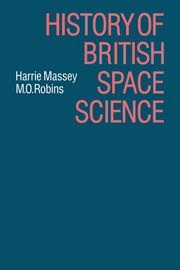Book contents
- Frontmatter
- Contents
- Glossary of abbreviations in text and annexes
- Glossary of abbreviations in appendices
- Preface
- 1 The scientific background
- 2 The technical background
- 3 The initiation of the Skylark rocket programme – the IGY and artificial satellites
- 4 Post-IGY developments – NASA – COSPAR – British National Committee for Space Research – British satellite experiments
- 5 The Ariel programme
- 6 The European Space Research Organization
- 7 Commonwealth co-operation in space reseach
- 8 Smaller rockets for scientific purposes – Skua and Petrel
- 9 Attitude controlled Skylark rockets
- 10 The Trend Committee and the Science Research Council
- 11 The transformation of ESRO into ESA
- 12 The Space Science Committee for Europe
- 13 Scientific studies by British space scientists – figure of the earth and the neutral atmosphere
- 14 Scientific studies by British space scientists – the ionosphere, the magnetosphere and cosmic rays
- 15 The contribution from British space scientists to astronomy
- 16 Concluding remarks
- Appendices
- Annexes
- Notes
- Index
4 - Post-IGY developments – NASA – COSPAR – British National Committee for Space Research – British satellite experiments
Published online by Cambridge University Press: 05 February 2012
- Frontmatter
- Contents
- Glossary of abbreviations in text and annexes
- Glossary of abbreviations in appendices
- Preface
- 1 The scientific background
- 2 The technical background
- 3 The initiation of the Skylark rocket programme – the IGY and artificial satellites
- 4 Post-IGY developments – NASA – COSPAR – British National Committee for Space Research – British satellite experiments
- 5 The Ariel programme
- 6 The European Space Research Organization
- 7 Commonwealth co-operation in space reseach
- 8 Smaller rockets for scientific purposes – Skua and Petrel
- 9 Attitude controlled Skylark rockets
- 10 The Trend Committee and the Science Research Council
- 11 The transformation of ESRO into ESA
- 12 The Space Science Committee for Europe
- 13 Scientific studies by British space scientists – figure of the earth and the neutral atmosphere
- 14 Scientific studies by British space scientists – the ionosphere, the magnetosphere and cosmic rays
- 15 The contribution from British space scientists to astronomy
- 16 Concluding remarks
- Appendices
- Annexes
- Notes
- Index
Summary
We have already pointed out that it was quite clear that the rocket and satellite programme in the IGY would continue and, indeed, expand after that ‘year’ had terminated (31 December 1958). Permanent organizational arrangements had therefore to be set up in advance of that date. Even in the USA the pre-IGY programme was based on the use of sounding rockets and was comparatively small so that it did not call for elaborate organization. The launching of satellites was quite another matter. This new activity called for a much more elaborate organization in the USA while in the UK it was obviously clear that the ad hoc IGY arrangement of the Artificial Satellite Sub-committee would need to be translated into some more permanent organizational form.
The National Aeronautics and Space Administration (NASA) in the USA
The launching of Sputnik I had a traumatic effect throughout the USA. To many, it seemed that the Russians had stolen a march on them and that it was vital to catch up without delay if the security of the USA were not to be jeopardized. President Eisenhower was one of the few who did not take this view and remained unperturbed. However, the urge to make up for lost ground as rapidly as possible was at first channelled to a large extent into the examination of the administrative structure within which space research, not only space science but also applications both civil and military, would be carried out.
- Type
- Chapter
- Information
- History of British Space Science , pp. 54 - 73Publisher: Cambridge University PressPrint publication year: 1986



